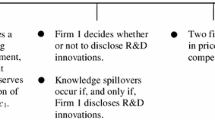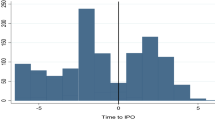Abstract
Invention disclosure is a complex problem faced by many university faculty members. Existing studies have investigated related issues, but few researchers have considered disclosure from the perspectives of both disclosure stage (early or late) and disclosure type (university or firm). This paper seeks to address this gap by investigating the influence of economic benefit, reputation, competition and collaboration on invention disclosure. We build several theoretical models, finding that reputation and competition have opposite effects on university disclosure, whereas economic benefit and collaboration are positively related to firm disclosure. We also find these four influencing factors have close relationships with disclosure stage. The simulation results further illustrate that initial reputation and additional reputation have different impacts on disclosure stage. An increase in a faculty and firm’s capability incentivizes firm disclosure in the early stage, while the competitor’s capability has the opposite impact. However, entry cost relates negatively to the disclosure stage and to the multi-stage disclosure. This paper provides insights for faculty on invention disclosure, as well as implications for university management.

Similar content being viewed by others
References
Aghion, P., & Tirole, J. (1994). The management of innovation. Quarterly Journal of Economics, 109, 1185–1209.
Audretsch, D. B., Bonte, W., & Keilbach, M. (2008). Entrepreneurship capital and its impact on knowledge diffusion and economic performance. Journal of Business Venturing, 23, 687–698.
Baker, S., & Mezzetti, C. (2005). Disclosure as a strategy in the patent race. Journal of Law and Economics, 48(1), 173–194.
Baldini, N. (2009). Implementing Bayh-Dole-like laws: Faculty problems and their impact on university patenting activity. Research Policy, 38, 1217–1224.
Baldini, N., Grimaldi, R., & Sobrero, M. (2005). Motivations and incentives for patenting within universities: A survey of Italian inventors. Paper presented at the Annual Meeting of Academy of Management, New York.
Bloch, F., & Markowitz, P. (1996). Optimal disclosure delay in multistage R&D competition. International Journal of Industrial Organization, 14, 159–179.
Bozeman, B. (2000). Technology transfer and public policy: A review of research and theory. Research Policy, 29, 627–655.
Clancy, M. S., & Moschini, G. C. (2013). Incentives for innovation: Patents, prizes, and research contracts. Applied Economic Perspectives and Policy, 35(2), 206–241.
Cohen, W. M., & Walsh, J. P. (2008). Real impediments to academic biomedical research. Innovation Policy and the Economy, 8, 1–30.
Crama, P., Reyck, B. D., & Degraeve, Z. (2008). Milestone payments or royalty? Contract design for R&D licensing. Operational Research, 56, 1539–1552.
Crespi, G.A., Geuna, A., Verspagen, B. (2006). University IPRs and knowledge transfer. Is the IPR ownership model more efficient? Roundtable Engineering Entrepreneurship Research, Georgia Institute of Technology.
Dechenaux, E., Thursby, M., & Thursby, J. (2009). Shirking, sharing risk and shelving: The role of university license contracts. International Journal of Industrial Organization, 27, 80–91.
Dechenaux, E., Thursby, J., & Thursby, M. (2011). Faculty moral hazard in university licensing: The role of contracts. Research Policy, 40, 94–104.
Etzkowitz, H. (2003). Research groups as “quasi-firms”: The invention of the entrepreneurial university. Research Policy, 32, 109–121.
Fini, R., Lacetera, N., & Shane, S. (2010). Inside or outside the IP system? Business creation in academia. Research Policy, 39, 1060–1069.
Friedman, J., & Silberman, J. (2003). University technology transfer: Do incentives, management, and location matter? The Journal of Technology Transfer, 28, 17–30.
Fuller, A. W. (2008). University entrepreneurship: The role of US faculty in technology transfer and commercialization. Atlanta: Georgia Institute of Technology.
Gans, J., Murray, F. (2014). Markets for scientific attribution. Working paper.
George, G., Jain, S., & Maltarich, M. A. (2005). Academics or entrepreneurs? Entrepreneurial identity and invention disclosure behavior of university scientists. Working paper.
Geuna, A., & Muscio, A. (2009). The governance of university knowledge transfer: A critical review of the literature. Minerva, 47, 93–114.
Gregorio, D. D., & Shane, S. (2003). Why do some universities generate more start-ups than others? Research Policy, 32, 209–227.
Grimaldi, R., Kenney, M., Siegel, D. S., & Wright, M. (2011). 30 years after Bayh-Dole: Reassessing academic entrepreneurship. Research Policy, 40, 1045–1057.
Haeussler, C., Jiang, L., Thursby, J., & Thursby, M. (2014). Specific and general information sharing among competing academic researchers. Research Policy, 43(3), 465–475.
Hellmann, T. (2007). The role of patents for bridging the science to market gap. Journal of Economic Behavior and Organization, 63, 624–647.
Henderson, R., Jaffe, A. B., & Trajtenberg, M. (1998). Universities as a source of commercial technology: A detailed analysis of university patenting 1965–1988. The Review of Economics and Statistics, 80, 119–127.
Humberstone, R. (2009). The impact of university licensing behavior on scientist disclosure. Working paper.
Jensen, R. A., Thursby, J. G., & Thursby, M. C. (2003a). Disclosure and licensing of university inventions: ‘The best we can do with the s**t we get to work with’. International Journal of Industrial Organization, 21, 1271–1300.
Jensen, R., Thursby, J.G., Thursby, M.C. (2003). The disclosure and licensing of university inventions. Working paper.
Jensen, R., Thursby, J., Thursby, M. (2011). University-industry spillovers, government funding, and industry consulting. Working paper.
Jiang, L., Thursby, J.G., Thursby, M.C. (2012). Scientific disclosure and the face of competition. Working paper.
Johnson, W. H. A., & Qing, L. (2011). Patenting and the role of technology markets in regional innovation in China: An empirical analysis. Journal of High Technology Management Research, 22, 14–15.
Macho-Stadler, I., & Perez-Castrillo, D. (2010). Incentives in university technology transfers. International Journal of Industrial Organization, 28, 362–367.
Mowery, D. C., & Shane, S. (2002). Introduction to the special issue on university entrepreneurship and technology transfer. Management Science, 481, 5–9.
Murray, F., & O’Mahony, S. (2007). Exploring the foundations of cumulative innovation: Implications for organization science. Organization Science, 18(6), 1006–1021.
Nizovtsev, D., Thursby, M. (2005). Economic analysis of incentives to disclose software vulnerabilities. Working paper.
Owen-Smith, J., & Powell, W. W. (2001). To patent or not: Faculty decisions and institutional success at technology transfer. Journal of Technology Transfer, 26, 99–114.
Panagopoulos, A., & Carayannis, E. G. (2013). A policy for enhancing the disclosure of university faculty invention. Journal of Technology Transfer, 38, 341–347.
Powers, J. B., & McDougall, P. P. (2005). University start-up formation and technology licensing with firms that go public: A resource-based view of academic entrepreneurship. Journal of Business Venturing, 20, 291–311.
Rothaermel, F. T., Agung, S., & Jiang, L. (2007). University entrepreneurship: A taxonomy of the literature. Industrial and Corporate Change, 16(4), 691–791.
Rudyk, I. (2013). Deferred patent examination. Working paper.
Siegel, D. S., Waldman, D., & Link, A. (2003). Commercial knowledge transfers from university to firms: Improving the effectiveness of university-industry collaboration. Journal of High Technology Management Research, 14, 111–133.
Thursby, J. G., Fuller, A. W., & Thursby, M. C. (2009). US faculty patenting: Inside and outside the university. Research Policy, 38, 14–25.
Thursby, J. G., & Kemp, S. (2002). Growth and productive efficiency of university intellectual property licensing. Research Policy, 31, 109–124.
Thursby, J. G., & Thursby, M. C. (2002). Who is selling the ivory tower? Source of growth in university licensing. Management Science, 48, 1–15.
Thursby, J. G., & Thursby, M. C. (2011). Faculty participation in licensing: Implications for research. Research Policy, 40, 20–29.
Thursby, M., Thursby, J., Dechenaux, E. (2005). Shirking, sharing risk and shelving: The role of university license contracts. Working paper.
Venditti, M., Reale, E., & Leydesdorff, L. (2013). Disclosure of university research to third parties: A non-market perspective on an Italian university. Science and Public Policy, 40, 792–800.
Wentzel, K. R., & Watkins, D. E. (2002). Peer relationships and collaborative learning as contexts for academic enablers. School Psychology Review, 31(3), 366–377.
Author information
Authors and Affiliations
Corresponding author
Appendix
Appendix
1.1 Proof of Eq. (6)
In this study, we believe faculty’s disclosure decisions depend on their current and future expected payoffs. Therefore, if the current expected payoff is larger than the future one, and the current expected payoff is the larger one, faculty disclosure their inventions in the current stage and then choose either university disclosure or firm disclosure. Based on this principle, we derive the following:
In order to find the largest expected payoff, we use
Then, according to Eq. (5), we find that
The maximization problem of disclosure stage is then written as:
1.2 Proof of Eq. (8)
When we do not consider risk preference, faculty disclose their inventions at the same level of probability for each stage, i.e., p = 0.5. In addition, we also assume faculty would choose university or firm disclosure at the same level of probability, i.e., q = 0.5. Therefore, Eq. (5) is as below:
In order to make this equation more clear and concise, we denote
Then, we rewrite F(r t ), yielding:
F(r t ) is a function of r t . Then, according to Eq. (5), a recurrence equation, we find the following:
1.3 Simulation detail
In Sect. 3.3, the optimization problems in four scenarios are too complex to obtain analytical solutions. It is difficult to analyze the marginal effect of each parameters, such as μ, b, q i , q f and q c . Therefore, we create simulation cases to examine each parameter’s influence.
First, according to Eqs. (14) and (15), we identify faculty’s research capability. All cases are then assigned to one of four scenarios: S1:\( q_{i} < \hbox{min} \left\{ {q_{c} ,q_{f} } \right\} \), S2:\( q_{f} \le q_{i} \le q_{c} \), S3:\( q_{c} \le q_{i} \le q_{f} \), S4:\( q_{i} > \hbox{max} \left\{ {q_{c} ,q_{f} } \right\} \).
Second, we assume the technology absorptivity rate is 0.85, according to Haeussler et al. (2014). The other parameters, such as μ, b, q i , q f , q c and \( k \equiv {K \mathord{\left/ {\vphantom {K V}} \right. \kern-0pt} V} \), vary over (0,1).
Based on these settings, each parameter has multiple values. We then solved the problem using MATLAB 2007b. The basic program file is as below:


Run the above program by MATLAB 2007b and then 16,384 cases are created.
Rights and permissions
About this article
Cite this article
Chang, Xh., Chen, Q. & Fong, P.S.W. University invention disclosure: balancing the optimal stage and type. J Technol Transf 42, 510–537 (2017). https://doi.org/10.1007/s10961-016-9489-0
Published:
Issue Date:
DOI: https://doi.org/10.1007/s10961-016-9489-0




